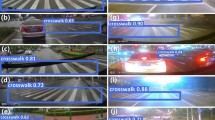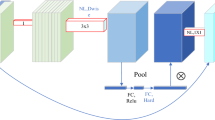Abstract
For a traditional traffic situational awareness system (TSAS), its “Road-side unit (RSU) + cloud-based analysis” structure is difficult to meet the demands of rapidly expanding urban areas. Relatively high costs of microwave speed detection modules and bandwidth requirements of information systems significantly increase construction costs. By computer vision (CV) and edge computing technologies, traffic situational awareness tasks can be integrated into cheaper edge devices (roadside surveillance, RSS), effectively addressing such challenges. In this study, we present a low-cost TSAS developed based on YOLO v8 and grey wolf optimizer-long short-term memory (GWO-LSTM) neural network. Proposed system can automatically perform vehicle and license plate recognition, speed measurement, and data recording within the field of view of RSSs. Additionally, it accurately predicts the future traffic conditions of monitored roads using recorded information. Experimental results demonstrate that the proposed TSAS achieves a license plate recognition accuracy of 97.7%, vehicle type recognition accuracy of 98.1%, and speed measurement error of less than 0.45 km/h, with R2 of 0.8971 for GWO-LSTM predictions. This system is sufficiently effective for traffic monitoring and situational awareness tasks but enforcement forensic applications.










Similar content being viewed by others
Data availability
No datasets were generated or analysed during the current study.
References
Li, Q., Ng, K.K., Simon, C., Yiu, C.Y., Lyu, M.: Recognising situation awareness associated with different workloads using EEG and eye-tracking features in air traffic control tasks. Knowl.-Based Syst. 260, 110179 (2023)
Alavizadeh, H., et al.: A survey on cyber situation-awareness systems: Framework, techniques, and insights. ACM Comput. Surv. 55(5), 1–37 (2022)
Basheer Ahmed, M.I., et al.: A real-time computer vision based approach to detection and classification of traffic incidents. Big Data Cognitive Comput. 7(1), 22 (2023)
Haghighat, A., Sharma, A.: A computer vision-based deep learning model to detect wrong-way driving using pan–tilt–zoom traffic cameras. Comput.-Aided Civil Infrastruct. Eng. 38(1), 119–132 (2023)
SAH Alhuthali, MYI Zia, M Rashid: "A simplified traffic flow monitoring system using computer vision techniques," in 2022 2nd International Conference on Computing and Information Technology (ICCIT), IEEE, pp. 167–170 (2020)
Bemposta Rosende, S., Ghisler, S., Fernández-Andrés, J., Sánchez-Soriano, J.: Implementation of an Edge-computing vision system on reduced-board computers embedded in UAVs for intelligent traffic management. Drones 7(11), 682 (2023)
Azfar, T., Li, J., Yu, H., Cheu, R.L., Lv, Y., Ke, R.: Deep learning-based computer vision methods for complex traffic environments perception: A review. Data Sci. Transport. 6(1), 1 (2024)
Shojaiee, F., Baleghi, Y.: EFASPP U-Net for semantic segmentation of night traffic scenes using fusion of visible and thermal images. Eng. Appl. Artif. Intell. 117, 105627 (2023)
S. Yuan et al., "Spatial deep deconvolution u-net for traffic analyses with distributed acoustic sensing," IEEE Transactions on Intelligent Transportation Systems (2023)
S Kolekar, S Gite, B Pradhan, A Alamri (2022) Explainable AI in scene understanding for autonomous vehicles in unstructured traffic environments on Indian roads using the inception U-Net Model with Grad-CAM visualization, sensors https://doi.org/10.3390/s22249677
Lin, C.-J., Jhang, J.-Y.: Intelligent traffic-monitoring system based on YOLO and convolutional fuzzy neural networks. IEEE Access 10, 14120–14133 (2022)
Mittal, U., Chawla, P., Tiwari, R.: EnsembleNet: A hybrid approach for vehicle detection and estimation of traffic density based on faster R-CNN and YOLO models. Neural Comput. Appl. 35(6), 4755–4774 (2023)
Hasan, S., Sunny, M.N.M., Al Nahian, A., Yasin, M.: Neural network-powered license plate recognition system design. Engineering 16(9), 284–300 (2024)
T. Barbu and S.-I. Bejinariu: "CNN-based Moving Vehicle Recognition using GMM-based Foreground Modeling, Level-set based Segmentation and Kalman Filter-based Tracking," in 2024 International Conference on INnovations in Intelligent SysTems and Applications (INISTA), IEEE, pp. 1–6 (2024)
Singh, S.K., Jha, S., Gupta, R.: Enhancing the accuracy of wind speed estimation model using an efficient hybrid deep learning algorithm. Sustain. Energy Technol. Assess. 61, 103603 (2024)
Hussain, M.: YOLO-v1 to YOLO-v8, the rise of YOLO and its complementary nature toward digital manufacturing and industrial defect detection. Machines 11(7), 677 (2023)
Duraisamy P.: "Implementation of YOLO V8 for Advanced Autonomous Vehicle Detection Techniques," Grenze International Journal of Engineering & Technology (GIJET), vol. 10, (2024)
Alruwaili, M., et al.: Deep learning-based YOLO models for the detection of people with disabilities. IEEE Access 12(2543), 2566 (2023)
Moussaoui, H., et al.: Enhancing automated vehicle identification by integrating YOLO v8 and OCR techniques for high-precision license plate detection and recognition. Sci. Rep. 14(1), 14389 (2024)
Yang, T., Zhou, S., Xu, A., Ye, J., Yin, J.: YOLO-SegNet: a method for individual street tree segmentation based on the improved YOLOv8 and the SegFormer network. Agriculture 14(9), 1620 (2024)
Z. Liu, F. Li, L. Hou, and Y. Shi: "Multi-Object Tracking Algorithm Based on Improved ByteTrack," in 2024 6th International Conference on Electronics and Communication, Network and Computer Technology (ECNCT), IEEE, pp. 463–468 (2024)
Mouafo, D., Biaou, U.: Uncalibrated camera approach for vehicle speed estimation using detection and tracking. SIViP 18(12), 8819–8827 (2024)
S.-R. Wang, C.-C. Hsu, C.-W. Peng, and C.-K. Lu: "Enhanced Speed Estimation Based on 2D Object Detection and Monocular Vehicle Pose Estimation," in 2024 IEEE International Conference on Consumer Electronics (ICCE), IEEE, pp. 1–2 (2024)
F. M. Shiri, T. Perumal, N. Mustapha, and R. Mohamed: "A comprehensive overview and comparative analysis on deep learning models: CNN, RNN, LSTM, GRU," arXiv preprint arXiv:2305.17473, (2023)
Bai, Y., Xiang, S., Cheng, F., Zhao, J.: A dynamic-inner LSTM prediction method for key alarm variables forecasting in chemical process. Chin. J. Chem. Eng. 55, 266–276 (2023)
Niu, Z., Qi, H., Sun, A., Ren, Y., He, M., Gao, B.: Efficient and robust CNN-LSTM prediction of flame temperature aided light field online tomography. SCIENCE CHINA Technol. Sci. 67(1), 271–284 (2024)
Wang, Z., Wang, Q., Wu, T.: A novel hybrid model for water quality prediction based on VMD and IGOA optimized for LSTM. Front. Environ. Sci. Eng. 17(7), 88 (2023)
Hatta, N., Zain, A.M., Sallehuddin, R., Shayfull, Z., Yusoff, Y.: Recent studies on optimisation method of grey wolf optimiser (GWO): a review (2014–2017). Artif. Intell. Rev. 52, 2651–2683 (2019)
Ma, C., Gu, K., Zhao, Y., Wang, T.: Research on highway traffic flow prediction based on a hybrid model of ARIMA–GWO–LSTM. Neural Comput. Appl. (2024). https://doi.org/10.1007/s00521-024-10550-2
Zhao, W., Yang, Y., Lu, Z.: Interval short-term traffic flow prediction method based on CEEMDAN-SE nosie reduction and LSTM optimized by GWO. Wirel. Commun. Mob. Comput. 2022(1), 5257353 (2022)
Acknowledgements
This work was supported by Guangdong Youth Innovative Talent Project (2023KQNCX109), Guangdong College Students Science and Technology Innovation Cultivation Special Fund Project (pdjh2024a469)
Author information
Authors and Affiliations
Contributions
J.L. wrote manuscript and R.G revised tge manuscript; Y.G, Z.L and Z.C prove test and validation works about this research.
Corresponding author
Ethics declarations
Conflict of interest
The authors declare no competing interests.
Additional information
Publisher's Note
Springer Nature remains neutral with regard to jurisdictional claims in published maps and institutional affiliations.
Rights and permissions
Springer Nature or its licensor (e.g. a society or other partner) holds exclusive rights to this article under a publishing agreement with the author(s) or other rightsholder(s); author self-archiving of the accepted manuscript version of this article is solely governed by the terms of such publishing agreement and applicable law.
About this article
Cite this article
Liu, J., Gong, R., Gong, Y. et al. Low-cost real-time traffic situational awareness system based on modified YOLO v8 and GWO-LSTM for edge deployment. J Real-Time Image Proc 22, 89 (2025). https://doi.org/10.1007/s11554-025-01657-3
Received:
Accepted:
Published:
DOI: https://doi.org/10.1007/s11554-025-01657-3




